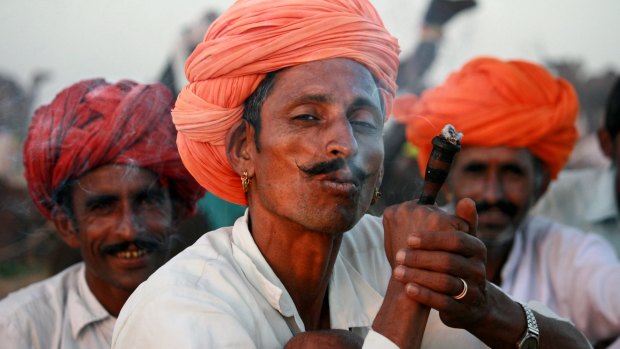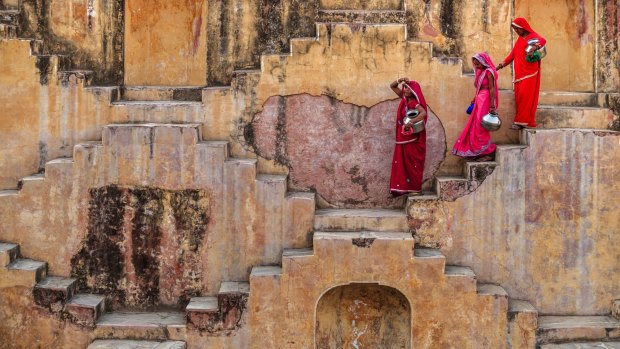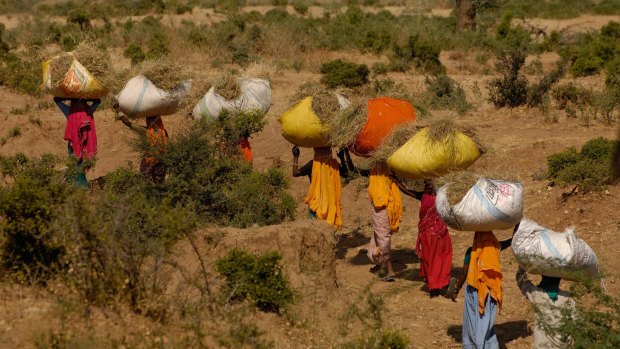This was published 4 years ago
A slice of everyday life inside India's Ranthambore National Park
By Nina Karnikowski

Rajasthani camel drivers smoking chillum.Credit: Alamy
The woman squats barefoot in the earth before the open fire, her head draped in a neon-orange scarf, slapping chapati dough from palm to palm. We watch her, sipping sweet, spicy chai from handmade terracotta cups and letting the smoke encircle us, feeling like we've travelled 200 years back in time. From here, we can see inside the woman's home, a simple rammed-earth structure with two rooms to house her and nine of her family members, spanning three generations.
"Seventy per cent of my countrymen live like this," whispers our expert guide, Madhav Das Rathore, an elegant Rajasthani native. "So if you haven't seen this, you haven't seen my country."
He's right, of course. Although we have seen some truly incredible sights so far on our seven-night APT luxury train journey through the Indian state of Rajasthan – the floating palaces of Udaipur, Jodhpur's imposing Mehrangarh Fort, the world's largest residential building in Gujarat – it's this insight into rural village life inside Ranthambore National Park that has us feeling especially connected to the soul of India. It's also an unexpectedly delightful extra, since like most travellers to Ranthambore we came to see the dwindling tiger population, which the park was established to protect in 1980.

Indian women carrying water from a stepwell.Credit: iStock
Most of the 100-odd homes scattered throughout the small village of Ramsinghpura are rammed-earth structures, ochre-coloured and hand-painted with white folk-art scenes of rural life. My favourite depicts a group of peacocks being stalked by a tiger.
"Tigers do cross through here," says Rathore, stroking his magnificent grey moustache while pointing at the art. "But the locals will never kill them, especially since the government introduced a protection scheme to replace any cattle killed by tigers."
The villagers, he says, live in equilibrium with the world's largest cat species, which are sometimes spotted prowling the swept courtyards that dot the village. I can't imagine being able to sleep while big cats roam a few metres away, but then life here isn't life as I know it. It's life unconcerned by the 21st century, a hidden Rajasthan a world away from the tourist crowds we've experienced elsewhere on the Jaipur-Jodhpur-Udaipur trail.

Village women carrying dried sticks home for firewood.Credit: Alamy
As we continue wandering the streets, we pass lush fields of marigolds and plantations of guava – which has been grown here since the mid-'80s to bring in extra income for the locals – and peer through the gaps of the loose brush fences at slender goats and chocolate-coloured cows. The cows, we're told, are used for everything here, providing the locals with milk and butter to eat, leather to wear and dung with which to build their houses. Even their bones are used – burnt, with the ash used as an insecticide.
"Nothing goes to waste, because these villagers can't afford to waste," says Rathore.
Mostly, we watch the villagers busily going about their agrarian lives. There are women draped in hot-pink and yellow harvesting spinach in the fields, a trio of cheeky young boys pushing an old bike wheel down a dusty alleyway, and sun-ripened old men in white dhotis squatting in the dirt beneath a grass-roofed shack, drinking tea – "the most popular place in the village, their equivalent of the pub," says Rathore, laughing.
The backdrop to these scenes is the majestic Aravalli Range, one of the oldest and longest mountain ranges in the world, rumbling on for some 800 kilometres and bisecting most of Rajasthan.
When we pass through the village's main square, Rathore points out a small shrine beneath a neem tree. "If the villagers have a dispute, they can't afford to go to the police or to court, so this is where the elders will gather and decide how to settle it," he says. "Because at the end of the day, everyone in this village is family, so they need to stay together and work it out."
Another sign of just how tight-knit this community is comes at the next house we pass, a more modern-looking concrete structure with baby-blue walls extravagantly painted with bright horses, flowers and Hindi words.
"You know about putting your status on the wall with Facebook? Well, this is where it comes from," says Rathore. "This is this family's latest status, it's actually a wedding invitation from two weeks ago, and everyone was invited." If there was a wedding being celebrated today, you get the distinct feeling we would be invited, without hesitation, too. It's just that kind of place.
Soon, it's time to exit this bucolic scene, to climb into handsome olive-green safari trucks and head into the jungle on a game drive. We spend the afternoon on the hunt, bumping through the dusty park grounds forested with cactus, palm and banyan trees. We spot countless langur monkeys playing in the trees, delicate spotted deer and snuffling warthogs grazing in the dense undergrowth, peacocks strutting along the road, and a crocodile in the park's tranquil Surwal lake. Despite our best tracking efforts, however, we do not see any tigers, only an indistinct paw print pressed into the dirt.
Not that it matters. The quiet morning in the village, the thrill of bumping through the jungle on a safari drive, that's enough for us. Especially when the latter ends as all good game drives should: with fire, and tea.
As night falls, we arrive at the Vivanta Sawai Madhopur Lodge, an erstwhile hunting lodge belonging to the Maharaja of Jaipur, built in 1936. Fires are lit, samosas and tea served, a turbaned magician makes coins disappear and doves materialise from thin air. "This is big magic," he says, midway through his act. Indeed, I believe it is.
TRIP NOTES
MORE
TOUR
APT's 17-day Spirit of India tour, which includes seven nights on the Deccan Odyssey, starts from $16,895 a person twin share. See aptouring.com.au
FLY
Singapore Airlines operates multiple daily flights between Sydney, Melbourne and Brisbane and Mumbai, via Singapore. See singaporeair.com
FIVE MORE THINGS TO DO IN RANTHAMBORE
RANTHAMBORE FORT
The evocative ruins of this 1000-year-old hill fort are set dramatically on a cliff within the tiger reserve. Inside, you'll find palaces, cenotaphs, pavilions and temples scattered among a network of lanes and courtyards.
HOT AIR BALLOONING
To get a bird's eye view of the lush forests and villages below, take a hot air balloon ride over Ranthambore. Worth it for the photo opportunities alone.
KACHIDA VALLEY
Located close to the park's outskirts, the Kachida Valley is your best bet for spotting panthers, which avoid venturing into the central areas to avoid territorial clashes with tigers. The valley also has a large population of sloth bears.
CRAFT COLLECTIVES
Various craft collectives are scattered around Ranthambore's periphery, including Dastkar Cooperative and Village Women Craft, where community members create intricately woven quilts, embroidered pillow cases and more. They provide local communities with extra income, so they're good places to spend your tourist dollar.
NATURAL HISTORY MUSEUM
The Rajiv Gandhi natural history museum, set on three hectares of manicured grounds, is worth an hour's visit. You'll see exhibits on local flora and fauna, geology and tribes, and animal artefacts, including a stuffed lion and tiger.
Nina Karnikowski travelled as a guest of APT.
Sign up for the Traveller Deals newsletter
Get exclusive travel deals delivered straight to your inbox. Sign up now.